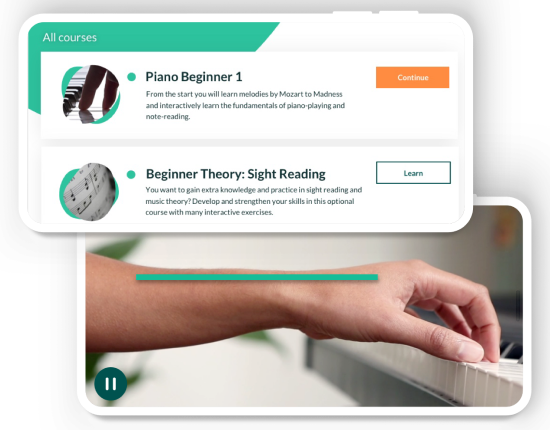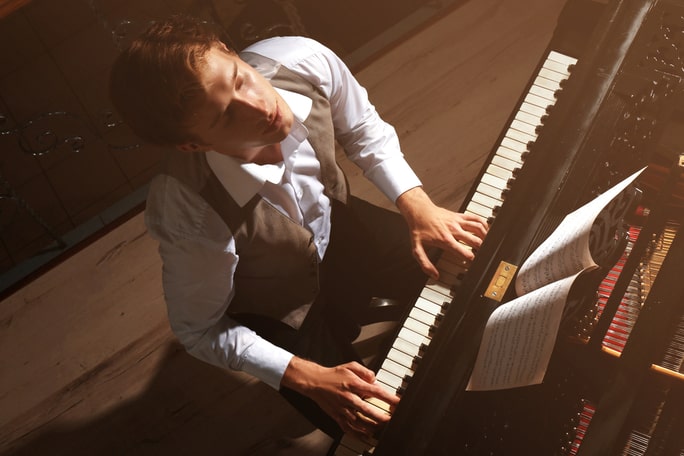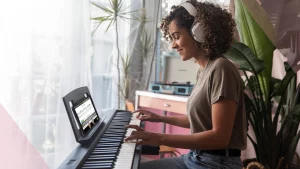Table of Contents
There are few things more exciting in music than when an instrumentalist takes a solo. The energy is usually high and the momentum of the moment is exhilarating and inspiring. One of the most exciting parts of learning to play the piano is developing the ability to play your own piano solos. Yes, it can be intimidating at first to try and solo. You might be full of doubt and not know what you should be playing. But, the more you listen to great solos of all styles and the more your try and practice, the better and more interesting your solos will become.
Skoove Premium is a unique take on online piano lessons. Skoove’s AI system listens and responds to your playing in real time, helping you to get better, faster. There is a wide range of repertoire to suit many interests and progressive levels of difficulty so that practicing remains fun and stress free. Plus, you can always try out a free seven day trial, just to get a feel for the program. You won’t regret it!
In this post you will learn about 8 great piano solos. Obviously, music is subjective and a solo that resonates with me might not resonate with you as much. These solos are chosen to cover a wide range of styles and are intended to open doors to musical styles and artists you might not have otherwise discovered. They are also not presented in a particular order of importance. Enjoy!

Brad Mehldau – “Wonderwall”
Brad Mehldau established himself as a dominant force in the world of jazz music in the late 1990s and early 2000s. His mind-bending technique combined with a unique vision for the meeting places between tradition and innovation have produced some of the most intriguing piano music of the last hundred years.
His jazz piano solo on the song by English rock band Oasis is a memorable one. Full of darting rhythms and collaborative interplay amongst the musicians, this piece is a perfect example of how you can transform a song into a popular piano solo by twisting a few rules around.
Norah Jones – “Don’t Know Why”
Norah Jones is an award winning pianist, vocalist, and songwriter who has been a major force in music for about two decades now. The daughter of the famous sitar playing Ravi Shankar, Jones was named Jazz Artist of the Decade by Billboard for the 2000s. She has won nine Grammy Awards and sold more than 50 million records worldwide. Quite a list of accomplishments!
Her composition “Don’t Know Why” has become something of a standard in piano and jazz repertoire and is one of the most beautiful piano solo songs in recent memory. Her piano accompaniment on the verses and choruses is a great study in chord playing and her single note solo around 2:00 minutes in is a wonderful example of a simple and melodic solo that perfectly suits the vibe of the song.
Bill Evans – “Waltz for Debby”
Another formidable force in the history of jazz piano, Bill Evans was a major creative contributor to Miles Davis’s album Kind of Blue, the best selling jazz record of all time. Evans’ style was characterized by a uniquely compositional approach to improvisation and was informed as much by the jazz tradition as by composers Maurice Ravel and Claude Debussy. His use of chords is often described as expressionistic.
After his tenure with Davis, Evans primarily performed in a trio setting and composed a number of pieces that have become standards in jazz repertoire. This piece, “Waltz For Debby”, is one such composition and is widely regarded as one of the best piano songs of all time. This recording is part of his iconic series of performances at the legendary Village Vanguard club in New York.
Red Garland – “Bye Bye Blackbird”
Red Garland was the pianist in Miles Davis’s quintet before the arrival of Bill Evans. His playing was heavily influenced by bebop and blues and he made great use of the block chord technique. The block chord technique is a style of chord playing where the melody is voiced at the top and bottom of the chord. Melody notes in a song that are chord tones are voiced with a major sixth chord. Melody notes that are a non-chord tone are voiced with fully-diminished 7th chords. For some added ear training, see if you can pick out when Garland plays a major sixth chord and when he plays a fully-diminished 7th chord!
Check out Garland’s beautiful solo on the jazz standard “Bye Bye Blackbird” for a classic example of block chord playing. Garland’s chord changes are so smooth, he makes it sound nearly effortless. If you are interested in learning how to play chord solos in this style, Red Garland’s playing is a great place to start.
Ray Manzarek – “Light My Fire”
Ray Manzarek was the keyboardist for the famous Los Angeles rock band The Doors. The Doors began in 1965 when Manzarek met Jim Morrison while they were both students at UCLA Film School. They went on to record 6 albums in 5 years and became one of the most successful bands of the era with many songs that are still considered classics.
Manzarek primarily performed on organ in The Doors, showcasing the instrument’s distinct sound and capabilities. When discussing piano vs organ, it’s essential to note the differences in tonality, technique, and versatility. While the piano offers a wide dynamic range with its weighted keys and ability to produce both soft and loud sounds, the organ, especially in rock settings, can create sustained notes and offers a rich, full sound that can fill large spaces. Manzarek’s psychedelic, modal organ solo on this track “Light My Fire” is a great example of the possibilities of the organ and provides insights into how the two instruments can offer different musical experiences. His performance on the organ provides much we can learn and apply to the study of the piano, emphasizing the unique characteristics of each instrument.
Alicia Keys – “If I Ain’t Got You”
Alicia Keys is undoubtedly one of the most powerful creative forces of the last 40 years, at least. Her voice is instantly recognizable, her songwriting is extremely inspiring and emotional, and her piano style is well worth studying. A classically-trained pianist, Keys began composing songs by age 12 and was signed at 15 years old by Columbia Records.
This track “If I Ain’t Got You” is a classic of Keys’ repertoire and features a beautiful piano arrangement at the beginning and great, bluesy, RnB inspired chord playing throughout. If you are interested in learning more of this style, Alicia Keys “If I Ain’t Got You” is a great place to start! This song also makes a great solo piano piece.
Bruce Hornsby – “The Way It Is”
Bruce Hornsby is an American songwriter and pianist who has had an interesting and prolific career. He draws from classical, jazz, bluegrass, folk, Motown, gospel, rock, blues, and jam band musical traditions. His recordings have been recognized with industry awards, including the 1987 Grammy Award for Best New Artist with Bruce Hornsby and the Range, the 1990 Grammy Award for Best Bluegrass Album, and the 1994 Grammy Award for Best Pop Instrumental Performance.
His composition “The Way It Is” offers a wonderful example of how the piano can be used in rock and pop music. The opening piano riff is ear catching and melodically interesting and is one of the most famous solo piano pieces. Hornsby’s interjected chord stabs offer a satisfying punch. The main piano solo around 2:00 into the track is groovy and infectious and well worth a listen.
Robert Glasper – “So Beautiful”
Robert Glasper is one of the newer exponents of the piano in the last 15 years or so. He has seamlessly fused the jazz traditions of Cedar Walton, Mulgrew Miller, and Herbie Hancock with hip hop, RnB, and rock into a cohesive and brilliant new form of fusion that has earned him multiple Grammy awards and nominations. Glasper is an active collaborator with a wide range of today’s most creative musical artists.
This recording “So Beautiful” is from a live performance at Capitol Studios. This track is a great example of his innovations in chord playing and single note soloing as well as an awesome display of interplay in a piano trio setting. If you can learn to emulate the style of Robert Glasper, you will be well on your way to becoming an excellent pianist!
Conclusion
Hopefully you have found something inspiring in these 8, great piano solos! Remember, music is a never ending journey; there is always something more to learn and always a new song or artist to discover! The key is to always be searching!
Speaking of piano solos, did you know that the Guiness World Record for the longest piano solo is held by the Canadian pianist Chilly Gonzalez? In 2009 Gonzales performed for an astonishing 27 hours, 3 minutes, and 44 seconds and performed over 300 songs! Can you imagine?
Try out your free trial of Skoove today!
Author of this blog post

Eddie Bond is a multi-instrumentalist performer, composer, and music instructor currently based in Seattle, Washington USA. He has performed extensively in the US, Canada, Argentina, and China, released over 40 albums, and has over a decade experience working with music students of all ages and ability levels.














